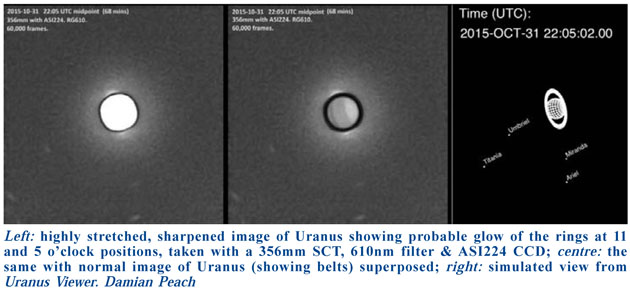Amateur detection of Uranus’ rings
2017 January 22
2016 December saw a flurry of interest in amateur imaging of the rings of Uranus. This feat was actually first achieved by German planetary imager Bernd Gährken (who has also done pioneering work on imaging the night side of Venus in infrared) back in 2011, using the 80cm Cassegrain telescope of the Bavarian Public Observatory, Munich, a methane-band filter (890nm), and a Brightstar Mammut CCD camera.1 He repeated these observations in 2012.2 However they seemed to remain little-known, perhaps because the first report is hidden at the end of a long webpage that seems at first to be on a different topic.
In 2013 Jean-Luc Dauvergne detected the rings with the 106cm Cassegrain telescope on Pic du Midi, a 900nm filter and an Andor Neo 5.5 cooled CMOS camera.3 He reported this on CloudyNights forum, but again, the observation received little attention in the community. Then on 2016 Nov 01 he made another detection with the 106cm telescope, this time with a near-infrared 685nm filter (one that many amateur planetary imagers possess) and the commonly-available ASI224 CMOS camera. This came to the attention of Marc Delcroix, Christophe Pellier and Jean-Phillipe Cazard, who had also been imaging Uranus with the 106cm telescope, and, after re-examining images they had obtained earlier on that telescope taken with ASI120MM and ASI290MM cameras, on Dec 17 they posted the news that their re-processed images from 2014 October and 2016 August also showed the rings. Delcroix commented that he had suspected something in his 2014 images at the time, but not followed it up, and he wondered whether the high IR sensitivity of the current CMOS cameras would now allow amateur instruments to be used to detect the rings (seemingly unaware of the earlier Munich observations with a smaller aperture).
 It did not take long for Delcroix’s question to be answered, for the very next day, Dec 18, Phil Miles & Anthony Wesley of Australia posted that they had detected the rings in images taken on 2016 Dec 13 with Miles’ 50cm Newtonian, 700nm and 610nm long-pass IR filters, and a PointGrey GS3-U3-32S4M camera.4 Wesley in turn speculated that detection might be possible in telescopes down to 14 inch (36cm) aperture, and this inspired the UK’s Damian Peach to look through the image collection taken with his Celestron 14 SCT. Immediately he identified an image taken in excellent seeing on 2015 Oct 31, with a 610nm filter and an ASI224 camera that, with suitable enhancement, revealed the rings in the correct orientation.5
It did not take long for Delcroix’s question to be answered, for the very next day, Dec 18, Phil Miles & Anthony Wesley of Australia posted that they had detected the rings in images taken on 2016 Dec 13 with Miles’ 50cm Newtonian, 700nm and 610nm long-pass IR filters, and a PointGrey GS3-U3-32S4M camera.4 Wesley in turn speculated that detection might be possible in telescopes down to 14 inch (36cm) aperture, and this inspired the UK’s Damian Peach to look through the image collection taken with his Celestron 14 SCT. Immediately he identified an image taken in excellent seeing on 2015 Oct 31, with a 610nm filter and an ASI224 camera that, with suitable enhancement, revealed the rings in the correct orientation.5
It is therefore now proven that ordinary amateur equipment will allow imaging of the rings of Uranus in the near infrared. It is possible that evidence of the rings is present in other datasets collected over the last few years, but was overlooked in processing for the disk details rather than these faint ring traces. The story of these ring observations generally just shows how important it is for amateurs to report surprising new results in ways that make the information well-known in the community of observers.
It is known from Voyager 2 and Hubble Space Telescope observations that Uranus has at least 13 separate rings.6 What is being seen in these amateur observations would appear to be light from the inner rings, unresolved, which occupy a space up to twice the diameter of the planet. The outermost and by far the brightest of these inner rings is the epsilon ring, so this would be responsible for most of the light detected. Over-brightening these amateur images enough to reveal this light results in an expanded glow from the planet overlapping the rings which, in the best images, just allows the ansae (or ‘ears’) of the inner ring system to be seen. This view can be compared with a simulation such as that from the SETI Institute Uranus Viewer7 to check the ring orientation (and positions of the satellites).
The rings will open up as seen from Earth until 2029, when they will be fully face-on to us. Wesley & Miles argue that this will make them harder to detect than they are at present because of lowered apparent surface brightness (and, one might add, because the excess glow will no longer be asymmetrical). It is clear that excellent seeing and good low-scatter optics are essential in detecting the rings, because of their faintness compared to the disk, which is more pronounced at near-optical wavelengths than at longer ones.
David Arditti
References & links
1 http://www.astrode.de/oppositionseffekte.htm
2 http://www.astrode.de/uring2012.htm
3 http://www.cloudynights.com/topic/429901-the-ring-of-uranus-from-the-pic-du-midi/
4 http://www.acquerra.com.au/astro/uranus-ring/#2
5 http://www.damianpeach.com/uranus_rings.jpg
| The British Astronomical Association supports amateur astronomers around the UK and the rest of the world. Find out more about the BAA or join us. |
